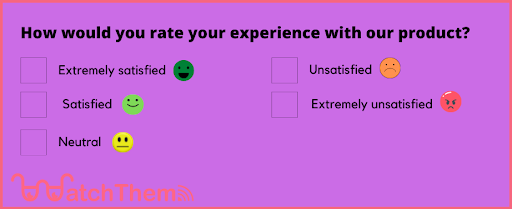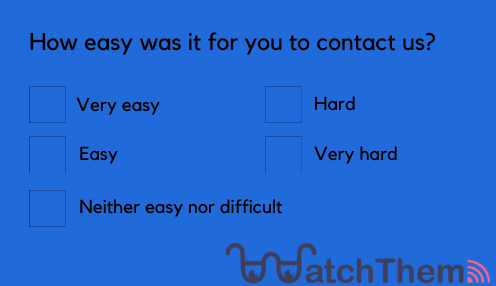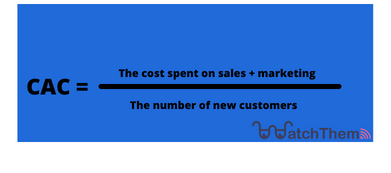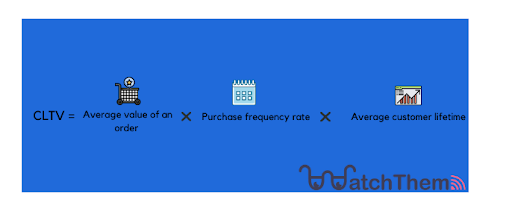Page Contents
Customer satisfaction is one of the most important factors in maintaining an eCommerce store. Let’s say one of your customers shows their dissatisfaction with your business; it’s very possible that lots of other customers are unsatisfied as well but decided to keep quiet. So even if there’s only one person, it’s crucial to answer their question, find the source of their pain, and offer them a better experience.
There are several customer satisfaction metrics that you need to track and measure if you want your online store to become successful. Keep reading this article to find out more.
By using WatchThemLive’s session replays, you can track customers’ behavior to see if they are satisfied with your brand or not. Want session replays? Sign up and get started.
What Is Customer Satisfaction?
Customer satisfaction refers to how well your products or services meet customers’ needs and expectations. It’s not just about the satisfaction after purchasing the product; rather, it’s measured through the whole customer journey. So you need to track their entire journey, stage by stage, to see if they are satisfied with you or not.
For more information about the customer journey stages, you can follow the link.
What Types of Metrics Measure Customer Satisfaction?
To understand which one of the customer satisfaction metrics suits your online store the best, you should first set your goals to see what you want to achieve. Customer experience (CX) metrics, or customer satisfaction metrics play a significant role in helping your business grow. Let’s take a look at the most important metrics.
Net Promoter Score (NPS)
NPS is one of the most important customer satisfaction metrics that shows how loyal your customers are and if they introduce you to their friends or share their experience on social media. It helps you to identify the customers who need a push to become loyal to reduce your churn rate. It also shows you how satisfied they are with your product or services, and if they are recommending you to others.
NPS is easily measured with the answer your customers give to one question, and that is how likely it is for them to recommend you to their friends.
Based on their answers which is a number from 0 to 10, you can segment your customers:


- Detractors
Detractors are customers that rated you between 0-6. They are not satisfied with your brand, and they’re most likely going to bad-mouth you. Also, they might increase your churn rate.
- Passives
These customers rated you between 7-8. They like your brand, but they might need a push to love it. That means they shop from you, but they’re not loyal. Passives might recommend your brand or not, but they won’t stop others from purchasing from you.
- Promoters
Promoters are customers that rated you 9 or 10 and are your loyal customers. They are completely satisfied with your brand, and they actively recommend your brand to others.
How to Calculate NPS?
To calculate your NPS rate, you should use a simple formula. You have to subtract the percentage of detractors from the percentage of promoters. Your NPS rate is something between -100 to 100. Any number under 0 indicates a bad NPS, anything between 0 and 30 is good, a number between 30 and 70 is a very good score, and a score above 70 is a high NPS which shows customers’ loyalty.
When Do You Use NPS?
You should use NPS surveys after customers have a meaningful interaction with your brand. At this time customers know what you have to offer and can decide whether they want to recommend you to their friends or not.
Why Should You Use NPS?
NPS surveys show you the level of your customers’ loyalty and if they would introduce you to others.
NPS Pros and Cons
There are advantages and disadvantages to everything. Satisfaction metrics are not an exception. Before deciding whether you want to use the NPS survey you should know its pros and cons:
Pros
- Easy to use and intuitive
- It’s linked to the growth of your business
- Makes benchmarking easy as it is popular worldwide
Cons
- It’s not specific enough
- You should have a plan to make the survey useful
2. Customer Satisfaction Score (CSAT)
CSAT is a key performance indicator that shows your customers’ satisfaction with your services or products.
How to Calculate CSAT?


To calculate CSAT, you should first decide on the question you want to ask customers. Then you can run a survey and ask your customers how satisfied they are while interacting with your brand, and how they will rate you on a scale from 0 to 10.
The answer options shouldn’t necessarily be numbers. For example, they can be:
- Extremely unsatisfied
- Unsatisfied
- Neutral
- Satisfied
- Extremely satisfied
Now that you have the answers, it’s time to calculate your CSAT. You can do this by the following formula:
(Number of satisfied customers / Number of survey responses) x 100 = % of satisfied customers
When Should You Use CSAT?
As CSAT is about the overall satisfaction of your customers, you can use it at any stage of the customer journey.
CSAT Pros and Cons
Let’s see the good and the bad aspects of CSAT:
Pros
- Easy to use and intuitive
- Based on the context, the rating scale can be numbers, words, stars, etc.
- Usually, the response rate is high because the questions are few.
Cons
- It only reflects short-term sentiments.
- Because of the wide-ranging benchmark data, you can’t be sure what a good or bad score is.
WatchThemLive is a platform that helps you understand customers’ experiences. With its user tracking feature, you can follow every step of your customers’ during their whole journey. Using this, you can understand if your users are satisfied with your brand or not. Sign up now to see what’s waiting for you!
3. Customer Effort Score (CES)


One of the most important customer satisfaction metrics is CES, which measures the efforts your customers had to put in to purchase a product, get answers to their questions, or contact you.
How to Calculate CES?
To measure CES, firstly, you have to run a survey asking a specific question such as: on a scale of ‘very easy’ to ‘very hard,’ how easy was it for you to contact us?
Using CES, you can make customers’ interactions with your brand as effortless as possible, which will result in customer loyalty. You should keep in mind that CES is not very subjective; it’s more about expectations. There is nothing you can call a good CES. It’s just about what your customers expect from you. Some might think that contacting the company was easy, and some might think it was hard.
The percentage of the answers chosen between “very easy” to “easy” is the percentage of your CES and indicates that contacting you is easy.
When Do You Use CES?
You can use CES at any customer journey stage to see which part of their journey was unsatisfying.
CES Pros and Cons
So let’s see CES pros and cons:
Pros
- It’s a reliable source when it comes to customers’ satisfaction and behavior
- It can be calculated at any stage of customers’ journey
- Compared to other metrics, it’s better at predicting customers’ loyalty and repurchases
Cons
- It’s limited to only one service and not your whole business, which means it only measures the effort for just one specific action
- It doesn’t say what are customers’ difficulties specifically
4. Customer Acquisition Cost (CAC)
CAC is the amount of money you have to spend to acquire a new customer. It shows your customers’ satisfaction with the interactions before purchasing and the customer service. CAC helps you understand if the amount of money you invest (in advertising, sales, and promotion, the salary of your employees, etc.) is actually coming back.
By using this metric you can find out if your business is growing in the right direction without spending more than what you earn. If you want to grow in the right and profitable direction you also have to look at these 2 metrics alongside CAC:
- Customer lifetime value (CLTV)
- Periods of repayments
How to Calculate CAC?
You can calculate your CAC using this formula:
CAC = (the cost spent on sales + marketing) / (the number of new customers)


For example, imagine a company spends $25000 on acquiring new customers (including spending on advertising, employees’ salaries, and marketing) last month, and had 2000 purchases completed by new customers. So, their CAC will be $12.5.
Tracking this metric is important because if the amount of your CAC is more than your revenue in a long period of time, something is going wrong. It also helps you understand how important a customer is.
CAC Pros and Cons
Let’s see the advantages and disadvantages of tracking this metric:
Pros
- It’s easy to see the results
- Helps you optimize marketing efforts
Cons
- Knowing the cost of acquisition won’t help you so much unless you come with other plans to take action
- It has a short life-span
5. Customer Lifetime Value (CLTV)
CLTV or CLV is one of the most essential satisfaction metrics for a company as you need to spend less on keeping your existing customers than acquiring new ones. CLTV is the amount of money a customer spends on your brand as long as they are your customer. It also helps you decide how much money you need to invest in order to get new customers and keep the existing ones.
Customer lifetime value always comes with the customer acquisition cost. CAC is only helpful when it’s analyzed alongside CLTV as it shows you the lifetime return on investments.
How to Calculate CLTV?
You can calculate CLTV by the following formula:
CLTV = average value of an order × Purchase frequency rate × Average customer lifetime


For example, a swimmer who always buys swimsuits from you might be worth:
$200 per swimsuit x 5 pairs per year x 5 years
CLTV = $200 x 5 x 5 = $5000
So , the CLTV is $5000.
CLTV Pros and Cons
So, let’s see what advantages and disadvantages are to CLTV:
Pros
- CLTV leads to better marketing
- Instead of relying on just one marketing strategy, it forces a company to use several
- It puts the customer at the center of your business
Cons
- Predicting the future is difficult using this metric
- Businesses might only focus on a single customer segment
- It’s not based on facts. When your customers are not interacting with your brand, you have to guess what they’re doing and build your business based on guesses.
Conclusion
Before you decide which one of these metrics suits your business better, you should set your goals, then based on the kind of business you own you can choose a metric.
In this article, we explained everything you need to know about customer satisfaction metrics; their definition, formulas, some examples, and pros and cons.
Tracking your users’ behavior shows you how satisfied they are with your brand. With WatchThemLive’s session replays, you can have access to real-time data and every interaction your users have with your business. If you want this amazing tool, sign up and get started.


